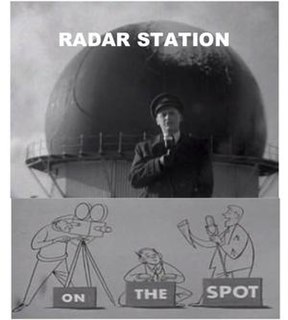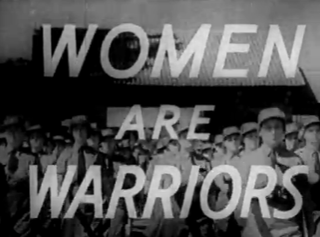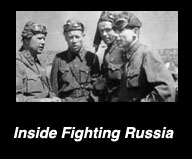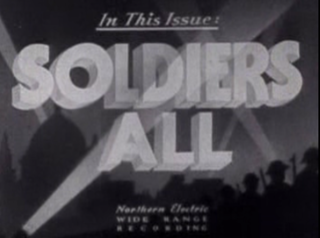
Churchill's Island is a 1941 propaganda film chronicling the defence of Britain during the Second World War. The film was directed by Stuart Legg and produced by the National Film Board of Canada (NFB) for the Director of Information, Government of Canada.

Now — The Peace is a film produced and directed in 1945 by Stuart Legg for the National Film Board of Canada series The World in Action, with unaccredited narration by Lorne Greene. Over its nearly 21-minute running time, circumstances during the immediate postwar period following the Second World War, leading to the formation of the United Nations are discussed.

Train Busters is a 13-minute 1943 Canadian documentary film, directed by Sydney Newman. The film was made by the Royal Canadian Air Force (RCAF) Overseas Film Unit and the National Film Board of Canada (NFB) as part of the NFB's Canada Carries On series. Train Busters depicts the Allied night bombing campaign over German-occupied Europe that was complemented by close air support missions flown by the RCAF targeting enemy trains.

Wings on Her Shoulder is a 10-minute 1943 Canadian documentary film, made by the National Film Board of Canada (NFB) as part of the NFB's The World in Action series. The film, directed by Jane Marsh, depicts the role of the Woman's Division in the Royal Canadian Air Force (RCAF) during the Second World War, who freed up men for flying duties.

Global Air Routes is a 14-minute 1944 Canadian documentary film produced by the National Film Board of Canada, directed and edited by Stuart Legg. The film is part of The World in Action series. Legg directed a number of documentaries for both The World in Action and earlier Canada Carries On series. Many of the documentaries were created as morale-boosting propaganda films during the Second World War.

Radar Station is a 1953 Canadian short documentary film produced by the National Film Board of Canada (NFB) as part of the On The Spot series made specifically for television. The documentary involved an account of a visit to a radar station while it is involved in a simulated air attack, and is based on first-person interviews of the staff at the radar station.

Ferry Pilot is a film produced in 1942 by Stuart Legg and Ross McLean for the National Film Board of Canada series The World in Action, in cooperation with the United Kingdom Ministry of Information and the Crown Film Unit. The film has an unaccredited narration by broadcaster Lorne Greene.

Our Northern Neighbour is a film produced in 1944 by Stuart Legg and directed by Tom Daly for the National Film Board of Canada series The World in Action. The film is narrated by broadcaster Lorne Greene.

Target - Berlin is a 15-minute 1944 Canadian documentary film, made by the National Film Board of Canada (NFB) as part of the wartime Canada Carries On series. The film was produced by Raymond Spottiswoode and directed by Ernest Borneman, from a story by Leslie McFarlane, based on the industrial production of the Avro Lancaster in Canada, from initial production to the first example taking part in a raid on Berlin. The film's French version title was Objectif Berlin.

Everywhere in the World is a 16-minute 1941 Canadian documentary film about the contributions of the United States and Commonwealth countries to the Allied war effort, made by the National Film Board of Canada (NFB) as part of the wartime Canada Carries On series. The film was produced by Stuart Legg. The film's French version title was Partout au monde.

The Home Front is a 10-minute 1940 Canadian documentary film, made by the National Film Board of Canada (NFB) as part of the wartime Canada Carries On series. The film was produced and directed by Stanley Hawes. The film's French version title is La Femme et la Guerre.

Women Are Warriors is a 14-minute 1942 Canadian documentary film, made by the National Film Board of Canada (NFB) as part of the wartime Canada Carries On series, and dealt with women in war. The film was produced by Raymond Spottiswoode and directed by Jane Marsh. The film's French version title is Les Femmes dans la mêlée.

Proudly She Marches is an 18-minute 1943 Canadian documentary film, made by the National Film Board of Canada (NFB) as part of the wartime Canada Carries On series. The film, directed by Jane Marsh and produced by Raymond Spottiswoode, described the work of Canadian women in uniform during the Second World War. The film's French version title is Carrières de femmes.

Inside Fighting Canada is an 11-minute 1942 Canadian documentary film, made by the National Film Board of Canada (NFB) as part of the wartime Canada Carries On series. The film, directed by Jane Marsh and produced by James Beveridge, was an account of the Canadian military during the Second World War. The film's French version title is Canada en guerre.

Inside Fighting Russia is a 1942 22-minute Canadian short documentary film produced by the National Film Board of Canada (NFB) for distribution by United Artists, as part of the wartime The World in Action series. The film documents Russia's fight against Nazi Germany during the Second World War. Inside Fighting Russia is produced by Stuart Legg, and narrated by Lorne Greene. The film's French version title is La Russie sous les armes.

Soldiers All is a 20-minute 1941 Canadian documentary film, made by the National Film Board of Canada as part of the wartime Canada Carries On series. The film was produced by Stuart Legg. Soldiers All describes the experiences in 1941 of soldiers, airmen and sailors in Great Britain and Canada during wartime. The film's French version title is Frères d'armes.

Back to Jobs is a nine-minute 1945 Canadian documentary film, made by the National Film Board of Canada (NFB) as part of the postwar Canada Carries On series. The film describes soldiers in the Second World War returning home and back to a civilian life. The French version title of Back to Jobs is Nos soldats reviennent .

The Voice of Action is a 16-minute 1942 Canadian documentary film, directed by James Beveridge and produced by Raymond Spottiswoode. The short film was made by the National Film Board of Canada (NFB) as part of the wartime Canada Carries On series. The Voice of Action describes the importance of the Canadian Broadcasting Corporation (CBC) in the Second World War. The French version title of The Voice of Action is Dynamisme des ondes.

Squadron 992 is a 23-minute 1940 British propaganda film produced by the General Post Office GPO Film Unit of the Ministry of Information and re-distributed by the National Film Board of Canada (NFB) as part of their wartime Canada Carries On series. The film was directed by Harry Watt and produced by Alberto Cavalcanti. Squadron 992 describes the training and operations in 1940 of No. 992 Squadron RAF, a Royal Air Force (RAF) barrage balloon unit stationed in the United Kingdom. The film's French version title was Escadrille 992.

Air Cadets is a 15-minute 1944 Canadian documentary film, made by the National Film Board of Canada (NFB) as part of the wartime Canada Carries On series. The film describes the Air Cadet Movement in 1944 during the Second World War. Air Cadets was directed by Jane Marsh, who was also the writer and editor on the production. The film's French version title is Les Cadets de l'air.





















